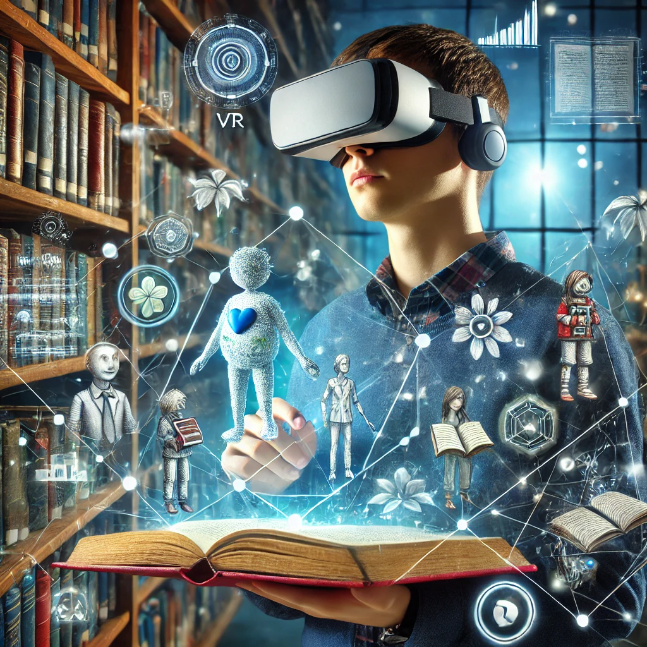Virtual and Augmented Reality (VR/AR) Storytelling and Books: The Future of Reading

The advent of Virtual Reality (VR) and Augmented Reality (AR) is transforming various industries, and the world of storytelling and books is no exception. These immersive technologies are revolutionizing how stories are told and experienced, creating new opportunities for authors and readers alike. In this article, we explore the impact of VR and AR on storytelling and books, the benefits they offer, and the future trends shaping this innovative landscape.
Understanding VR and AR
Virtual Reality (VR) creates a fully immersive digital environment that users can explore and interact with using VR headsets and controllers. This technology transports readers into the story, making them active participants in the narrative.
Augmented Reality (AR) overlays digital information onto the real world using devices like smartphones, tablets, and AR glasses. AR enhances the physical environment with interactive elements, providing a blended experience of reality and digital content.
The Impact of VR/AR on Storytelling and Books
1. Immersive Storytelling
VR and AR enable authors to create immersive storytelling experiences that go beyond traditional text. In VR, readers can step into the story, interact with characters, and explore settings in a 360-degree environment. AR can bring book illustrations to life, allowing readers to interact with elements on the page.
2. Enhanced Engagement
These technologies significantly boost reader engagement by making stories more interactive and visually captivating. Readers can experience the narrative in a multi-sensory way, enhancing their emotional connection to the story and characters.
3. Educational Potential
VR and AR have tremendous potential in educational books, providing interactive learning experiences. For example, history books can offer virtual tours of ancient civilizations, while science books can display 3D models of the human body or the solar system.
4. Expanding Creative Boundaries
Authors and illustrators can push the boundaries of creativity by incorporating VR and AR elements into their work. These technologies allow for innovative storytelling techniques, such as branching narratives, interactive plots, and gamified experiences.
Key Applications of VR/AR in Storytelling and Books
1. VR Storybooks
VR storybooks transport readers into the heart of the story. For example, in a VR adaptation of a fantasy novel, readers can explore magical worlds, solve puzzles, and interact with mythical creatures. These experiences make reading more dynamic and engaging.
2. AR-Enhanced Books
AR-enhanced books bring static images and text to life. Children's books can feature characters that jump off the page and interact with the reader. Textbooks can include AR elements that provide additional information and interactive exercises, making learning more engaging.
3. Interactive Storytelling Apps
Apps that combine VR and AR elements offer unique storytelling experiences. Readers can choose their path in a story, solve mysteries, or participate in challenges. These apps blend reading with gaming, providing an entertaining and educational experience.
4. Mixed Reality Experiences
Mixed Reality (MR) combines elements of both VR and AR, creating a seamless integration of digital and physical worlds. MR storytelling allows readers to interact with both virtual and real-world elements, creating a hybrid experience that enhances immersion and engagement.
Benefits of VR/AR Storytelling
1. Increased Accessibility
VR and AR can make stories more accessible to a wider audience. For example, audio narration and interactive elements can help readers with visual impairments or learning disabilities enjoy and engage with the story.
2. Enhanced Retention and Comprehension
Interactive and immersive experiences improve information retention and comprehension. Readers are more likely to remember details and understand complex concepts when they can see, hear, and interact with the content.
3. New Revenue Streams for Authors
Authors can monetize VR and AR content through app stores, subscription services, and in-app purchases. These technologies open up new revenue streams and business models for authors and publishers.
Future Trends in VR/AR Storytelling
1. Increased Adoption and Integration
As VR and AR technologies become more accessible and affordable, their adoption in the storytelling and publishing industry is expected to grow. More authors and publishers will experiment with these technologies, leading to a wider variety of VR and AR content.
2. Collaborative Storytelling Platforms
Future platforms may allow multiple users to experience and interact with a story simultaneously. This collaborative approach can create shared experiences, such as virtual book clubs or interactive storytelling sessions.
3. AI-Driven Customization
Artificial Intelligence (AI) can personalize VR and AR experiences based on individual reader preferences and behavior. AI algorithms can tailor the story, characters, and interactions to provide a unique experience for each reader.
4. Integration with Other Technologies
The future of VR and AR storytelling may see integration with other emerging technologies, such as haptic feedback devices, biometric sensors, and advanced motion tracking. These innovations will enhance the immersive experience, making stories even more interactive and engaging.
Conclusion
Virtual and Augmented Reality are transforming the storytelling and publishing industry by offering immersive, interactive, and engaging reading experiences. These technologies open up new possibilities for authors, illustrators, and readers, pushing the boundaries of traditional storytelling. As VR and AR continue to evolve, they will shape the future of reading, creating a rich and diverse landscape of interactive narratives. At SampleChaps.com, we are excited to explore these innovations and bring you the latest insights and trends in VR and AR storytelling.
For more insights into the evolving landscape of digital publishing, check out our article on The Future of Writing and Publishing: Blockchain Technology. Additionally, to learn about the integration of multimedia in e-books, read our article on Integration of Multimedia in E-books: Enhancing the Reading Experience.



